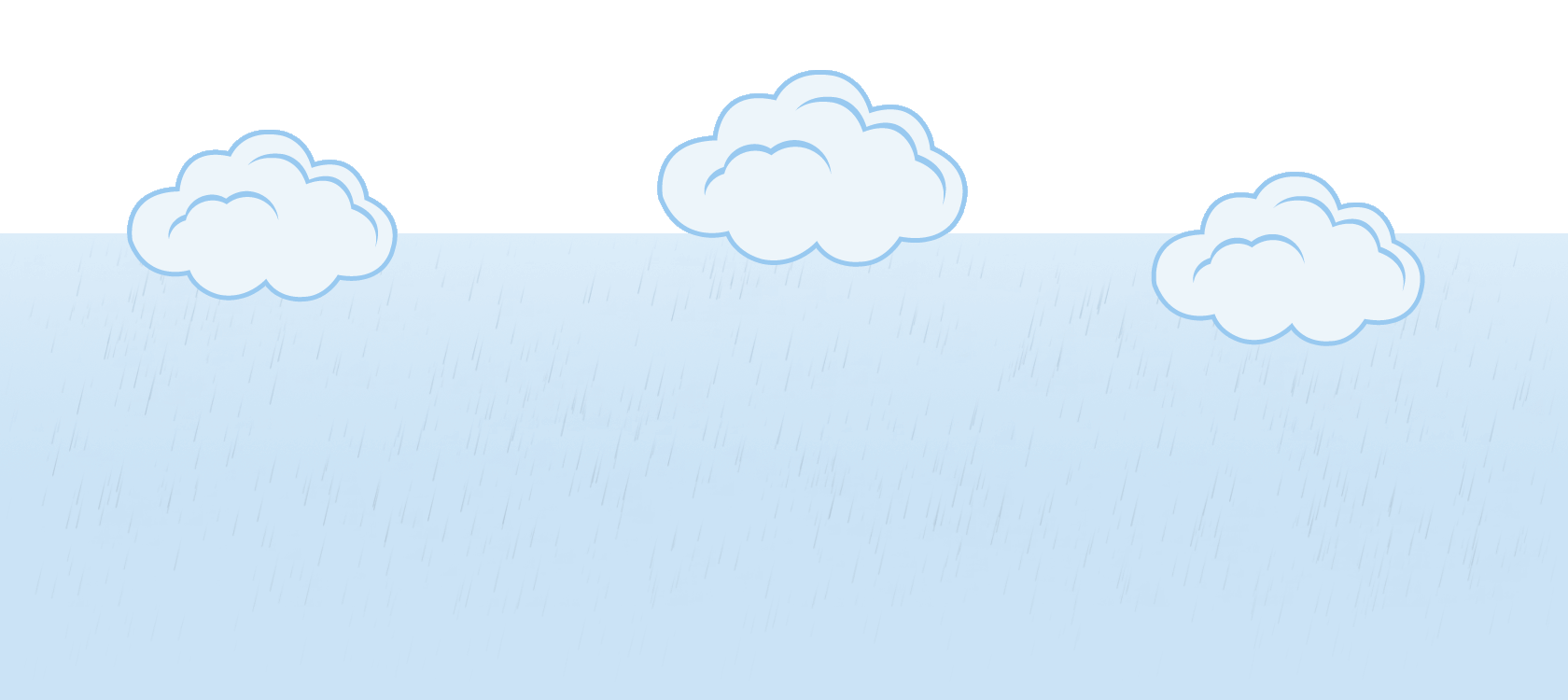Climate Literacy: The Essential Principles of Climate Sciences summarizes the most important principles and concepts of climate science. It presents information that individuals and communities need to understand Earth’s climate, impacts of climate change, and approaches for adapting to and mitigating change. This article provides science content knowledge for understanding Essential Principle 7: Climate change will have consequences for the Earth system and human lives. This principle describes current and predicted consequences of climate change. The importance of this principle is readily apparent: our world is changing, the degree of changes is projected to increase, and many of the consequences will create hardship for humans. Some key points are:
- The impacts of human-caused climate change are already being seen, from polar regions, to our backyards, to communities around the world.
- Consequences of climate change will affect the biosphere on many levels, from coral bleaching, to dying forests, to species extinction.
- Human infrastructure is threatened by a changing climate, such as encroachment of coastlines, stress to the energy grid, and shifting structures as a result of melting permafrost.
- A warming climate threatens mountain snowpacks, fresh water supplies, and hydropower that serve millions of people.
- Changes in climate and precipitation patterns will impact agriculture and food security.
- Populations that are already vulnerable in terms of sea-level rise and food security are poised for the greatest hardships. Political unrest, migration of refugees, and global economic impacts are all possible outcomes (Climate Literacy & Energy Awareness Network 2010).
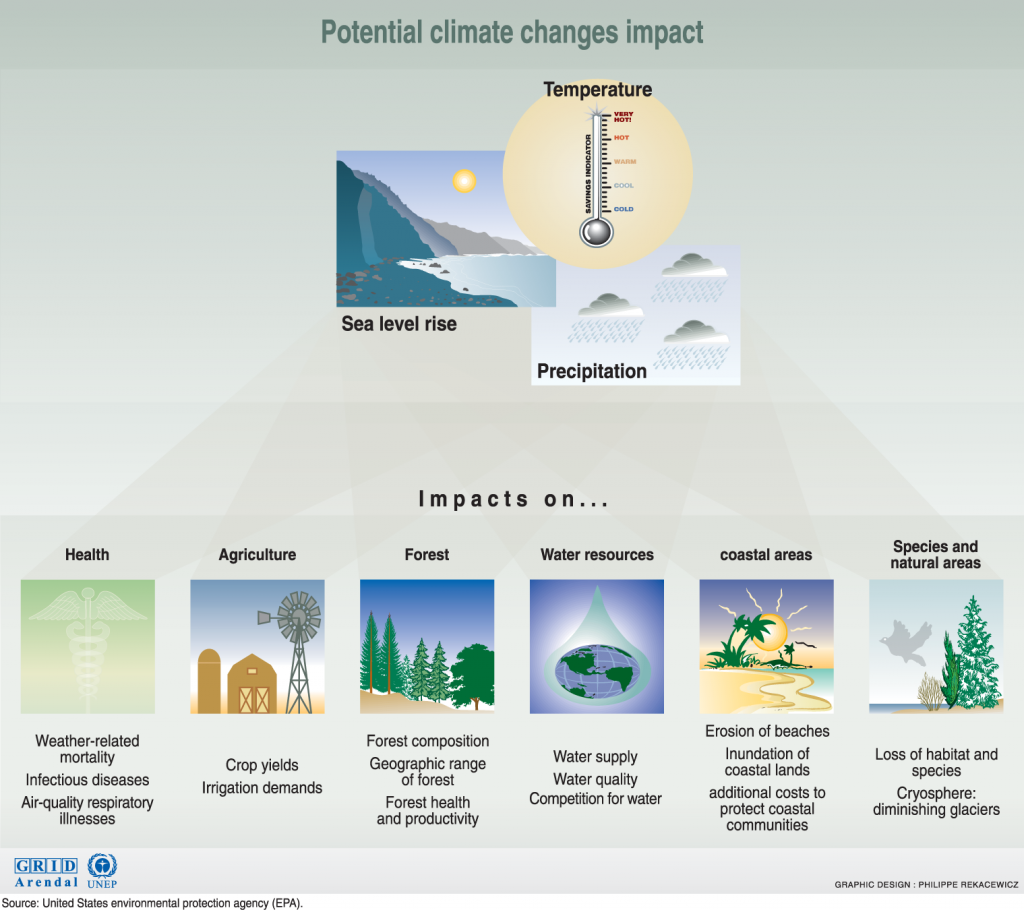
Potential climate change impacts. Graphic courtesy of Philippe Rekacewicz, UNEP/GRID-Arendal. Source: United States Environmental Protection Agency (EPA).
The following concepts are fundamental to understanding Principle 7. You can click on a concept to find the background knowledge to help you understand the concept.
Note: For additional ideas and resources for teaching each of the Essential Principles of Climate Sciences go to the Climate Literacy & Energy Awareness Network. Another good introduction to the seven essential principles is Earth: The Operator’s Manual, an hour-long film shown on PBS and based on the book of the same name by Richard Alley. The entire film is available but the site also provides short segments for teachers to preview and download (free, simple registration required), both with closed captioning for ESL and science comprehension support. A video from the U.S. Environmental Protection Agency (EPA), Climate 101 (second row, middle) explores what climate change is, signs or indicators that the planet is warming, and why it matters. Watch the video to learn more about the causes and effects of climate change and practical solutions to reduce carbon dioxide and other greenhouse gas emissions. An excellent rebuttal of climate change skeptics can be found in Why the Global Warming Skeptics Are Wrong (published 2/22/2012).
Concept A. Melting of ice sheets and glaciers, combined with the thermal expansion of seawater as the oceans warm, is causing sea level to rise. Seawater is beginning to move onto low-lying land and to contaminate coastal freshwater sources and beginning to submerge coastal facilities and barrier islands. Sea-level rise increases the risk of damage to homes and buildings from storm surges such as those that accompany hurricanes.
Concept B. Climate plays an important role in the global distribution of freshwater resources. Changing precipitation patterns and temperature conditions will alter the distribution and availability of freshwater resources, reducing reliable access to water for many people and their crops. Winter snowpack and mountain glaciers that provide water for human use are declining as a result of global warming.
Concept C. Incidents of extreme weather are projected to increase as a result of climate change. Many locations will see a substantial increase in the number of heat waves they experience per year and a likely decrease in episodes of severe cold. Precipitation events are expected to become less frequent but more intense in many areas, and droughts will be more frequent and severe in areas where average precipitation is projected to decrease.
Concept D. The chemistry of ocean water is changed by absorption of carbon dioxide from the atmosphere. Increasing carbon dioxide levels in the atmosphere is causing ocean water to become more acidic, threatening the survival of shell-building marine species and the entire food web of which they are a part.
Concept E. Ecosystems on land and in the ocean have been and will continue to be disturbed by climate change. Animals, plants, bacteria, and viruses will migrate to new areas with favorable climate conditions. Infectious diseases and certain species will be able to invade areas that they did not previously inhabit.
Concept F. Human health and mortality rates will be affected to different degrees in specific regions of the world as a result of climate change. Although cold-related deaths are predicted to decrease, other risks are predicted to rise. The incidence and geographical range of climate-sensitive infectious diseases—such as malaria, dengue fever, and tick-borne diseases—will increase. Drought-reduced crop yields, degraded air and water quality, and increased hazards in coastal and low-lying areas will contribute to unhealthy conditions, particularly for the most vulnerable populations.
You can also see where these concepts are found in national standards documents as well as common misconceptions in the Standards and Curriculum Connections article.
Concept A. Melting of ice sheets and glaciers, combined with the thermal expansion of seawater as the oceans warm, is causing sea level to rise. Seawater is beginning to move onto low-lying land and to contaminate coastal freshwater sources and beginning to submerge coastal facilities and barrier islands. Sea-level rise increases the risk of damage to homes and buildings from storm surges such as those that accompany hurricanes.
According to a 2011 study, ice sheets are now the largest contributor to rising sea levels. The study was conducted over the course of 20 years, and was published in the journal Geophysical Research Letters (Rignot et al. 2011). The researchers examined monthly satellite measurements between 1992 and 2009, using climate model data. The research shows that in 2006, Greenland and Antarctic ice sheets lost a combined mass of 475 gigatonnes – a tonne (or metric ton in the U.S.) is equivalent to 1000 kilograms (1 kg=2.2 pounds); a gigatonne would be 109 tonnes. This ice loss can raise the global sea level by 1.3 millimeters per year. The research also found that the ice sheets are melting at a steadily increasing rate. Over the course of the study, the ice sheets lost about an additional 36 gigatonnes per year compared to each year before.
The report’s lead author, Eric Rignot of NASA’s Jet Propulsion Laboratory, is not surprised that ice sheets now contribute the most to sea-level rise. But, Rignot remarks, “What is surprising is that this increased contribution by the ice sheets is already happening. If present trends continue, sea level is likely to be significantly higher than levels projected by the United Nations Intergovernmental Panel on Climate Change in 2007.” The trends suggest that by 2050, melting ice sheets could raise sea levels by nearly six inches – an amount that needs to be added to the predicted values from melting ice caps and ocean thermal expansion. The resulting calculations find that sea levels could rise to a total of 12.6 inches by 2050.
Another study shows that rising sea levels may threaten 180 U.S. cities by 2100 (Weiss, et al. 2011). This study was based on projections that sea levels will rise by about three feet within the next century. Cities such as Miami, New Orleans, and Virginia Beach are expected to lose over 10 percent of their land. New York and Washington, D.C., are also expected be impacted, though to a lesser degree.
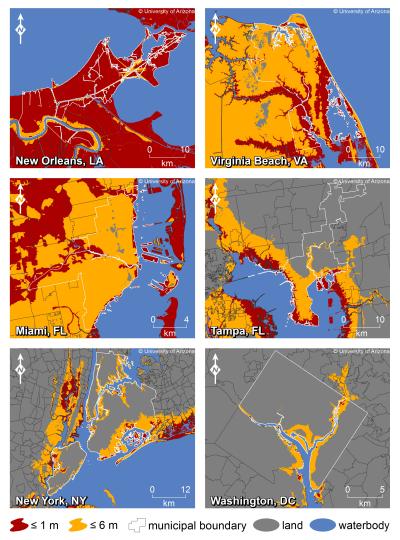
This map shows where increases in sea level could affect New Orleans, Virginia Beach, Va., Miami, Tampa, Fla., New York and Washington, D.C. The colors indicate areas along the coast that are elevations of 1 meter or less (russet) or 6 meters or less (yellow) and have connectivity to the sea. Image courtesy of Jeremy Weiss, University of Arizona. Usage Restrictions: This image may be used only to illustrate a story about the research described in the accompanying release, Rising Seas Will Affect Major U.S. Coastal Cities by 2100.
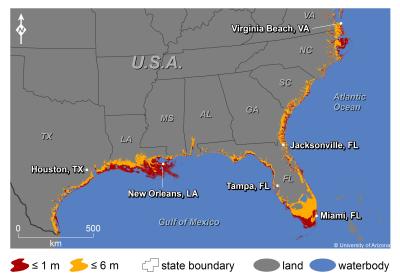
This map shows where increases in sea level could affect the southern and Gulf coasts of the U.S. The colors indicate areas along the coast that are elevations of 1 meter or less (russet) or 6 meters or less (yellow) and have connectivity to the sea. Image courtesy of Jeremy Weiss, University of Arizona. Usage Restrictions: This image may be used only to illustrate a story about the research described in the accompanying release, Rising Seas Will Affect Major U.S. Coastal Cities by 2100.
Related news release: Rising seas will affect major US coastal cities by 2100
Nationwide, about 5,000 square miles of dry land are within two feet of high tide. Although the majority of this land is currently undeveloped, many coastal counties continue to grow. Land within a few feet above the tides could be inundated by rising sea level, unless additional dikes and bulkheads are constructed. Rising sea levels inundate wetlands and other low-lying lands, erode beaches, intensify flooding, and increase the salinity of rivers, bays, and groundwater tables. Some of these effects may be further compounded by other effects of a changing climate. Additionally, measures that people take to protect private property from rising sea level may have adverse effects on the environment and on public uses of beaches and waterways. Some property owners and state and local governments are already starting to take measures to prepare for the consequences of rising sea level.
Related Resources
Snow to Ice to Water: Melt Ponds, Moulins, and Surging Glaciers
This article is about Jason Box, a research scientist at Ohio State University. He is researching the ponds and lakes that form on the surface of the Greenland ice sheet in the summer season. Studying these bodies of melted snow and ice (meltwater) helps scientists understand the behavior of glaciers and their response to the changes in climate.
Extreme Ice
An acclaimed photographer teams up with scientists to document the runaway melting of arctic glaciers. The video, which you can see in its entirety, aired December 28, 2011 on PBS.
Polar Ice Sheets Melting Faster Than Predicted
This article describes a study that shows ice loss from the massive ice sheets covering Greenland and Antarctica is accelerating.
Sea Level Rise to Alter Economics of California Beaches
While some beaches may shrink or possibly disappear due to climate change, others are poised to remain relatively large – leaving an uneven distribution of economic gains and losses for coastal beach towns.
Concept B. Climate plays an important role in the global distribution of freshwater resources. Changing precipitation patterns and temperature conditions will alter the distribution and availability of freshwater resources, reducing reliable access to water for many people and their crops. Winter snowpack and mountain glaciers that provide water for human use are declining as a result of global warming.
There are many unknowns in terms of how ecosystems and societies will be impacted by the loss of snow and ice which serve as reservoirs of freshwater. Runoff patterns may shift in many parts of the world with more rain and less snow falling as precipitation. Rising sea level increases the salinity of both surface water and ground water through salt water intrusion. New York City, Philadelphia, and much of California’s Central Valley obtain some of their water from portions of rivers that are slightly upstream from the point where water is salty during droughts. If sea-level rise pushes salty water upstream, then the existing water intakes might draw on salty water during dry periods. Salinity increases in estuaries also can harm aquatic plants and animals that do not tolerate high salinity.
Shallow coastal aquifers are also at risk (IPCC 2007). For instance, the freshwater Everglades currently recharge Florida’s Biscayne aquifer, the primary water supply to the Florida Keys. As rising water levels submerge low-lying portions of the Everglades, portions of the aquifer would become saline. Aquifers in New Jersey east of Philadelphia are recharged by fresh portions of the Delaware River that may become saline in the future. In all of these cases, water management authorities currently prevent excessive salinity by releasing freshwater from reservoirs during droughts. One possible response to sea-level rise would be to store more water during wet seasons so that more water can be released during droughts. However, other water management goals (e.g., flood prevention) may make it difficult to save extra water for the occasional drought.
The retreat of glaciers affects the availability of freshwater for irrigation and domestic use, mountain recreation, animals and plants that depend on glacier-melt, and in the longer term, the level of the oceans. According to the IPCC (2007) report, all the alpine glaciers of the world (with a few exceptions) are losing mass and it is predicted that this trend will continue as global warming progresses. Glaciers in alpine areas act as buffers. During the rainy season, water is stored in the glaciers and the meltwater helps maintain river systems during dry periods. An estimated 1.5 to 2 billion people in Asia (Himalayan region) and in Europe (the Alps) and the Americas (Andes and Rocky Mountains) depend on river systems with glaciers inside their catchment areas. In areas where the glaciers are melting, river runoff will increase for a period before a sharp decline in runoff. Without the water from mountain glaciers, serious problems are inevitable.The following image shows the retreats of both the Muir and Riggs Glaciers.
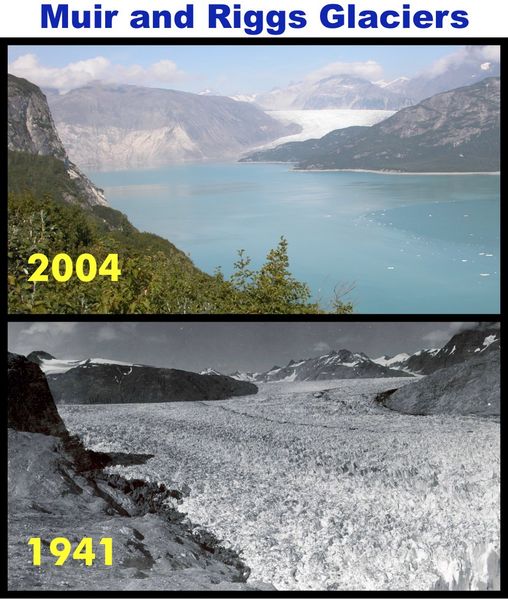
Comparison photos of Muir and Riggs Glaciers in Alaska between 1941 and 2004. During this time, the Muir glacier, which was >70 meters thick, has retreated out of the frame. Image courtesy of Robert A. Rohde, Wikimedia Commons.
Related Resources
Global Water Scarcity: Can We Solve It?
This article contains an interview with one of the authors of a study which provides fresh insight into the factors behind water shortages in the world’s most important river basins.
Repeat Photography of Glaciers Project
The Glacier Photograph Collection is an online, searchable collection of photographs of glaciers, mostly taken in the Rocky Mountains, the Pacific Northwest, Alaska, and Greenland. Photographs were taken from both the air and the ground. The dates of the photographs range from the mid-1800s to the present day. As of June 2010, more than 13,000 glacier photographs are online. Click on the Search and Order link to compare photographs taken of the same glaciers at different times.
Concept C. Incidents of extreme weather are projected to increase as a result of climate change. Many locations will see a substantial increase in the number of heat waves they experience per year and a likely decrease in episodes of severe cold. Precipitation events are expected to become less frequent but more intense in many areas, and droughts will be more frequent and severe in areas where average precipitation is projected to decrease.
Climate change has the potential to alter the prevalence and severity of extremes such as heat waves, cold waves, storms, floods and droughts. Though predicting changes in these types of events under a changing climate is difficult, understanding vulnerabilities to such changes is a critical part of estimating vulnerabilities and future climate change impacts on human health, society and the environment. According to the IPCC (2007) report, since 1950, the number of heat waves has increased and widespread increases have occurred in the numbers of warm nights. The extent of regions affected by droughts has also increased as precipitation over land has marginally decreased while evaporation has increased due to warmer conditions. Generally, numbers of heavy daily-precipitation events that lead to flooding have increased, but not everywhere. Tropical storm and hurricane frequencies vary considerably from year to year, but evidence suggests substantial increases in intensity and duration since the 1970s.

The heat engine known as Hurricane Floyd, in a NASA image. Photo courtesy of NOAA/NASA Goddard Space Flight Center.
Related Resources
Global Warming and Hurricanes
In this review of the literature, Thomas R. Knutson, research meteorologist at NOAA, unpacks two frequently asked questions on global warming and hurricanes: Have humans already caused a detectable increase in Atlantic hurricane activity? and What changes in hurricane activity are expected for the late 21st century, given the pronounced global warming scenarios from current IPCC models?
Stronger Hurricanes
Is global warming making hurricanes more intense? This six-minute video aired January 10, 2006, on PBS.
Hotter Oceans, Fiercer Storms
Have rising sea surface temperatures led in a general way to more intense hurricanes? Atmospheric scientist Kerry Emanuel and meteorologist Peter Webster and his team have gathered powerful evidence that this has been the case over recent decades. In this audio slide show, hear from both scientists and examine their data.
Concept D. The chemistry of ocean water is changed by absorption of carbon dioxide from the atmosphere. Increasing carbon dioxide levels in the atmosphere is causing ocean water to become more acidic, threatening the survival of shell-building marine species and the entire food web of which they are a part.
The oceans act like a sponge to draw down excess carbon dioxide from the air. The gas reacts with seawater to form carbonic acid, which over time is neutralized by fossil carbonate shells on the seafloor. If too much carbon dioxide enters the ocean too quickly, it can deplete the carbonate ions that corals, mollusks and some plankton need for reef and shell-building. The oceanic removal of carbon dioxide from the atmosphere has a cooling affect on global temperatures. Unfortunately, the increased carbon dioxide in the ocean changes the water, making it more acidic. With ocean temperatures and acidity levels increasing more every year, coral reefs are rapidly declining. The image below is a patch reef in Truk Lagoon, Micronesia. This reef is one of the most threatened, both by climate and human activities.
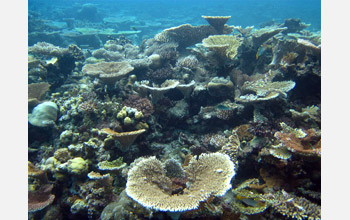
A patch reef in Truk lagoon, Micronesia. This reef is one of the most threatened, both by climate and human activities. Photo courtesy of Mikhail V. Matz, University of Texas, Austin.
Related Resources
Oceans Acidifying Faster Today Than in Past 300 Million Years
An article in the magazine Science examines the geologic record for context relating to ocean acidification, a lowering of the pH driven by the increased concentration of carbon dioxide in the atmosphere. The research group (21 scientists from nearly as many different universities) reviewed the evidence from past known or suspected intervals of ocean acidification. The work provides perspective on the current trend as well as the potential consequences. They find that the current rate of ocean acidification puts us on a track that, if continued, would likely be unprecedented in last 300 million years.
A CO2 Warning Etched in Stone and Sediment
This Dot Earth blog post starts with an overview of research on episodes of carbon-driven disruption of ocean and climate conditions over the last 300 million years. It ends with a video interview of Bryan Lovell, the president of the Geological Society of London, in which he discusses how humans have become a dominant influence on vital Earth systems.
Oceans, Climate, and Weather
Designed for middle school teachers, this online resource guide offers help in teaching about the relationships between oceans, weather, and climate and in reinforcing the teacher’s content knowledge of these topics. The guide identifies lessons and activities and sources of real data for analyzing and interpreting. The guide materials align with the National Science Education Standards.
Ocean Literacy: The Essential Principles of Ocean Sciences K-12
Ocean scientists and educators developed this outline of knowledge required to be considered ocean literate and in accordance with the National Science Education Standards. Their work was supported by ocean-related groups, including the National Geographic Society’s Oceans for Life Initiative and the National Oceanic and Atmospheric Administration (NOAA).
Climate Kids: What is Happening to the Oceans?
Produced by NASA’s Jet Propulsion Laboratory, this web site lists and answers “Big Questions” as well as “smaller questions” about the oceans, including how the oceans affect climate. Short video clip about the climate, games, and a list of educator resources.
Concept E. Ecosystems on land and in the ocean have been and will continue to be disturbed by climate change. Animals, plants, bacteria, and viruses will migrate to new areas with favorable climate conditions. Infectious diseases and certain species will be able to invade areas that they did not previously inhabit.
Most plants and animals live in areas with very specific climate conditions, such as temperature and rainfall patterns. Any change in the climate of an area can affect the plants and animals living there, as well as the makeup of the entire ecosystem. Plants and animals have adapted to changes in the environment for millions of years. However, today’s changes are happening faster and on a larger scale than in the past, which makes it difficult for plants and animals to adapt. Some species are already responding to a warmer climate by moving to cooler locations. For example, some North American animals and plants are moving farther north or to higher elevations to find suitable places to live. Species can also die out because they have only limited ability to adapt to environmental changes.
Climate change also alters the life cycles of plants and animals. For example, as temperatures get warmer, many plants are starting to grow and bloom earlier in the spring and survive longer into the fall. Some animals are waking from hibernation sooner or migrating at different times, too. Some unwelcome invaders (invasive species) could benefit from climate change by expanding their range or being able to survive through the winter in new places.
Related Resources
Climate Change Wildlife & Wildlands Toolkit and Video
This resource divides the United States into 11 distinct “ecoregions” based on a number of factors, including geography and habitat type. Each ecoregion includes a case study and activities that will bring alive the impacts and solutions to climate change. A 12-minute video on climate-change science and impacts on wildlife and their habitat is also available.
How Does Your Garden Grow? Discovering How Weather Patterns Affect Natural Cycles
Conducting a weather-fact scavenger hunt to explore how a warm winter has had effects on plant bloom times and other natural processes.
Life Science Session 5. Variation, Adaptation, and Natural Selection
This link goes to Session 5 of the Essential Science for Teachers: Life Science online course designed to help K-6 teachers enhance their understandings of “big ideas” in the life sciences. Each session includes a short video with background information and activities and lessons that support the content covered in the session.
Concept F Human health and mortality rates will be affected to different degrees in specific regions of the world as a result of climate change. Although cold-related deaths are predicted to decrease, other risks are predicted to rise. The incidence and geographical range of climate-sensitive infectious diseases—such as malaria, dengue fever, and tick-borne diseases—will increase. Drought-reduced crop yields, degraded air and water quality, and increased hazards in coastal and low-lying areas will contribute to unhealthy conditions, particularly for the most vulnerable populations.
Many elements of human society are sensitive to climate variability and change. Climate change not only leads to rising sea levels but also is linked to droughts, flooding, and food shortages. Human health is strongly affected by social, political, economic, environmental and technological factors, including urbanization, affluence, scientific developments, individual behavior and individual vulnerability (e.g., genetic makeup, nutritional status, emotional well-being, age, gender and economic status). The extent and nature of climate change impacts on human health vary by region, by relative vulnerability of population groups, by the extent and duration of exposure to climate change itself, and by society’s ability to adapt to or cope with the change. UN reports have predicted that because of climate change, the world will have 50 million environmental refugees by 2020.
The Intergovernmental Panel on Climate Change (IPCC 2007) concluded that human beings are exposed to climate change through changing weather patterns (for example, more intense and frequent extreme events) and indirectly through changes in water, air, food quality and quantity, ecosystems, agriculture, and economy. Climate change may increase the risk of some infectious diseases, particularly those diseases that appear in warm areas and are spread by mosquitoes and other insects. These “vector-borne” diseases include malaria, dengue fever, yellow fever, and encephalitis. Also, algal blooms could occur more frequently as temperatures warm — particularly in areas with polluted waters — in which case, diseases (such as cholera) that tend to accompany algal blooms could become more frequent.
Higher temperatures, in combination with favorable rainfall patterns, could prolong disease transmission seasons in some locations where certain diseases already exist. In other locations, climate change will decrease transmission via reductions in rainfall or temperatures that are too high for transmission. For example, temperature and humidity levels must be sufficient for certain disease-carrying vectors, such as ticks that carry Lyme disease, to thrive. And climate change could push temperature and humidity levels either toward or away from optimum conditions for the survival rate of ticks.
References
Climate Literacy & Energy Awareness Network. 2010. Teaching Essential Principle 7: Climate change will have consequences for the Earth system and human lives. Retrieved from http://cleanet.org/clean/literacy/principle_7.html.
Intergovernmental Panel on Climate Change (IPCC). 2007. Climate Change 2007: Synthesis Report. Retrieved from http://www.ipcc.ch/publications_and_data/ar4/syr/en/spms2.html.
Rignot, E., I. Velicogna, M. R. van den Broeke, A. Monaghan, and J. Lenaerts. 2011. “Acceleration of the Contribution of the Greenland and Antarctic Ice Sheets to Sea Level Rise.” Geophysical Research Letters 38, L05503. doi:10.1029/2011GL046583
Weiss, J. L., J. T. Overpeck, and B. Strauss. 2011. “Implications of Recent Sea Level Rise Science for Low-elevation Areas in Coastal Cities of the Conterminous U.S.A.” Climatic Change 105: 635-645. Press release available at http://www.eurekalert.org/pub_releases/2011-02/uoa-rsw021411.php
Kimberly Lightle wrote this article. She received her PhD in science education at The Ohio State University and is principal investigator of Beyond Weather and the Water Cycle, Beyond Penguins and Polar Bears, and the Middle School Portal 2 projects. Email Kim at beyondweather@msteacher.org
Copyright February 2012 – The Ohio State University. This material is based upon work supported by the National Science Foundation under Grant No. 1034922. Any opinions, findings, and conclusions or recommendations expressed in this material are those of the author(s) and do not necessarily reflect the views of the National Science Foundation. This work is licensed under an Attribution-ShareAlike 3.0 Unported Creative Commons license.
